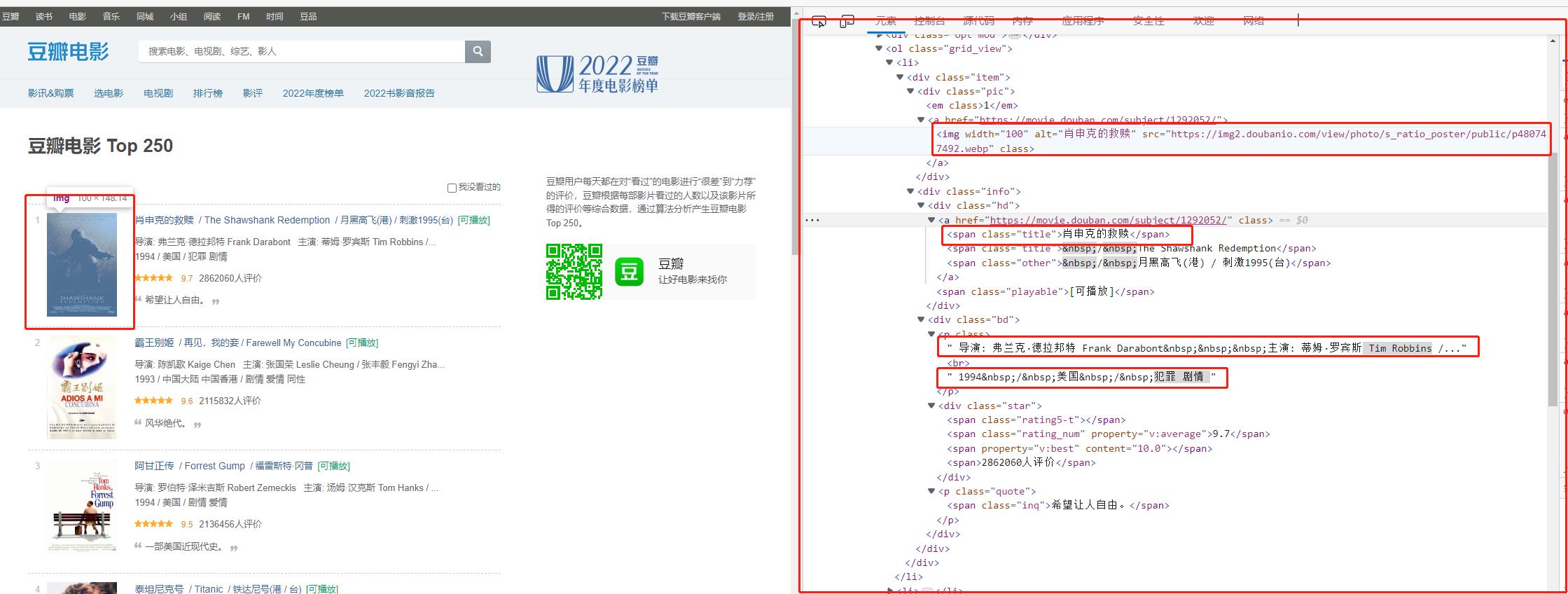通过模仿学会Python爬虫:零基础上手
Posted 养肥胖虎
tags:
篇首语:本文由小常识网(cha138.com)小编为大家整理,主要介绍了通过模仿学会Python爬虫:零基础上手相关的知识,希望对你有一定的参考价值。
好家伙,爬虫来了
爬虫,这玩意,不会怎么办,
诶,先抄一份作业回来
1.别人的爬虫
Python爬虫史上超详细讲解(零基础入门,老年人都看的懂)_ChenBinBini的博客-CSDN博客
# -*- codeing = utf-8 -*-
from bs4 import BeautifulSoup # 网页解析,获取数据
import re # 正则表达式,进行文字匹配`
import urllib.request, urllib.error # 制定URL,获取网页数据
import xlwt # 进行excel操作
#import sqlite3 # 进行SQLite数据库操作
findLink = re.compile(r\'<a href="(.*?)">\') # 创建正则表达式对象,标售规则 影片详情链接的规则
findImgSrc = re.compile(r\'<img.*src="(.*?)"\', re.S)
findTitle = re.compile(r\'<span class="title">(.*)</span>\')
findRating = re.compile(r\'<span class="rating_num" property="v:average">(.*)</span>\')
findJudge = re.compile(r\'<span>(\\d*)人评价</span>\')
findInq = re.compile(r\'<span class="inq">(.*)</span>\')
findBd = re.compile(r\'<p class="">(.*?)</p>\', re.S)
def main():
baseurl = "https://movie.douban.com/top250?start=" #要爬取的网页链接
# 1.爬取网页
datalist = getData(baseurl)
savepath = "豆瓣电影Top250.xls" #当前目录新建XLS,存储进去
# dbpath = "movie.db" #当前目录新建数据库,存储进去
# 3.保存数据
saveData(datalist,savepath) #2种存储方式可以只选择一种
# saveData2DB(datalist,dbpath)
# 爬取网页
def getData(baseurl):
datalist = [] #用来存储爬取的网页信息
for i in range(0, 10): # 调用获取页面信息的函数,10次
url = baseurl + str(i * 25)
html = askURL(url) # 保存获取到的网页源码
# 2.逐一解析数据
soup = BeautifulSoup(html, "html.parser")
for item in soup.find_all(\'div\', class_="item"): # 查找符合要求的字符串
data = [] # 保存一部电影所有信息
item = str(item)
link = re.findall(findLink, item)[0] # 通过正则表达式查找
data.append(link)
imgSrc = re.findall(findImgSrc, item)[0]
data.append(imgSrc)
titles = re.findall(findTitle, item)
if (len(titles) == 2):
ctitle = titles[0]
data.append(ctitle)
otitle = titles[1].replace("/", "") #消除转义字符
data.append(otitle)
else:
data.append(titles[0])
data.append(\' \')
rating = re.findall(findRating, item)[0]
data.append(rating)
judgeNum = re.findall(findJudge, item)[0]
data.append(judgeNum)
inq = re.findall(findInq, item)
if len(inq) != 0:
inq = inq[0].replace("。", "")
data.append(inq)
else:
data.append(" ")
bd = re.findall(findBd, item)[0]
bd = re.sub(\'<br(\\s+)?/>(\\s+)?\', "", bd)
bd = re.sub(\'/\', "", bd)
data.append(bd.strip())
datalist.append(data)
return datalist
# 得到指定一个URL的网页内容
def askURL(url):
head = # 模拟浏览器头部信息,向豆瓣服务器发送消息
"User-Agent": "Mozilla / 5.0(Windows NT 10.0; Win64; x64) AppleWebKit / 537.36(KHTML, like Gecko) Chrome / 80.0.3987.122 Safari / 537.36"
# 用户代理,表示告诉豆瓣服务器,我们是什么类型的机器、浏览器(本质上是告诉浏览器,我们可以接收什么水平的文件内容)
request = urllib.request.Request(url, headers=head)
html = ""
try:
response = urllib.request.urlopen(request)
html = response.read().decode("utf-8")
except urllib.error.URLError as e:
if hasattr(e, "code"):
print(e.code)
if hasattr(e, "reason"):
print(e.reason)
return html
# 保存数据到表格
def saveData(datalist,savepath):
print("save.......")
book = xlwt.Workbook(encoding="utf-8",style_compression=0) #创建workbook对象
sheet = book.add_sheet(\'豆瓣电影Top250\', cell_overwrite_ok=True) #创建工作表
col = ("电影详情链接","图片链接","影片中文名","影片外国名","评分","评价数","概况","相关信息")
for i in range(0,8):
sheet.write(0,i,col[i]) #列名
for i in range(0,250):
# print("第%d条" %(i+1)) #输出语句,用来测试
data = datalist[i]
for j in range(0,8):
sheet.write(i+1,j,data[j]) #数据
book.save(savepath) #保存
if __name__ == "__main__": # 当程序执行时
# 调用函数
main()
# init_db("movietest.db")
print("爬取完毕!")

卧槽,有点东西
这东西看上去挺nb啊,
也很方便,把我想要的一些数据直接总结到一个excel表格中了
我们来看看这些字段是如何匹配的
.xls

代码:
findLink = re.compile(r\'<a href="(.*?)">\') # 创建正则表达式对象,标售规则 影片详情链接的规则
findImgSrc = re.compile(r\'<img.*src="(.*?)"\', re.S)
findTitle = re.compile(r\'<span class="title">(.*)</span>\')
findRating = re.compile(r\'<span class="rating_num" property="v:average">(.*)</span>\')
findJudge = re.compile(r\'<span>(\\d*)人评价</span>\')
findInq = re.compile(r\'<span class="inq">(.*)</span>\')
findBd = re.compile(r\'<p class="">(.*?)</p>\', re.S)
<img>?<span>? 这不就专业对口了吗
网站的html:

将三个"表"都打开,再来看看对比

(诶都对上了)
此处,使用正则表达式去匹配对应标签
正则表达式 – 简介 | 菜鸟教程 (runoob.com)
于是看了这个案例之后,我们就可以大概去分析以下爬虫到底干了什么:
1.发请求,随后拿到服务器发过来的.html文件
2.用正则表达式去套对应的,我们需要的数据
3.处理数据,最后把他们以某种方式呈现
具体来说,爬虫通常会执行以下步骤:
-
发送HTTP请求:爬虫通过发送HTTP请求来获取目标网页的内容。
-
解析HTML页面:网页内容一般是HTML格式的,爬虫需要使用HTML解析器来将页面内容解析成Python对象。
-
提取数据:通过Python编程语言对解析出来的对象进行遍历和操作,找到需要的数据并保存下来。
-
存储数据:将提取的数据保存到文件中、数据库中或者内存中,以备后续的处理和分析。
-
处理异常:爬虫需要处理异常,例如:请求超时、解析错误等,以确保爬虫的稳定性和可靠性。
开干
2.我的爬虫
好了,我们自己写一个爬虫试试
import requests
from bs4 import BeautifulSoup
import xlwt
import re
# 创建Excel文件
workbook = xlwt.Workbook(encoding=\'utf-8\')
worksheet = workbook.add_sheet(\'kugou_rank\')
# pattern = re.compile(r\'(?<=- ).*\')
# 构造请求头
headers =
\'User-Agent\': \'Mozilla/5.0 (Windows NT 10.0; Win64; x64) AppleWebKit/537.36 (KHTML, like Gecko) Chrome/58.0.3029.110 Safari/537.36\'
# 定义排行榜页面的URL
url = \'https://www.kugou.com/yy/rank/home/1-6666.html?from=rank\'
# 发送请求并获取响应
r = requests.get(url, headers=headers)
# 解析HTML
soup = BeautifulSoup(r.text, \'html.parser\')
# 定位歌曲排行榜列表
song_list = soup.find(\'div\', \'class\': \'pc_temp_songlist\').find_all(\'li\')
# 将数据写入Excel文件
worksheet.write(0, 0, \'排名\') #写入对应的字段
worksheet.write(0, 1, \'歌名\')
worksheet.write(0, 2, \'歌手\')
worksheet.write(0, 3, \'专辑\')
worksheet.write(0, 4, \'播放时长\')
worksheet.write(0, 5, \'链接地址\')
row = 1
for song in song_list:
song_name = song.find(\'a\', \'class\': \'pc_temp_songname\').text.strip() #筛选出歌名
song_title = song.get(\'title\')
singer_pattern = re.compile(r\'.*(?= - )\')
song_singer = singer_pattern.findall(song_title)
song_title = song.get(\'title\')
print(song_title)
album_pattern = re.compile(r\'(?<=- ).*\')
song_album = album_pattern.findall(song_title)
# song_album = pattern.findall(song)
song_time = song.find(\'span\', \'class\': \'pc_temp_time\').text.strip()
link_pattern = re.compile(r\'href="(.*?)"\')
worksheet.write(row, 0, song[\'data-index\']) #将排行写入excel表格
worksheet.write(row, 1, song_name) #将歌名写入excel表格
worksheet.write(row, 2, song_singer) #将歌手写入excel表格
worksheet.write(row, 3, song_album) #将歌曲专辑写入excel表格
worksheet.write(row, 4, song_time) #将歌曲时长写入excel表格
song =str(song)
song = song.split("javascript:")[0]
song_link = link_pattern.findall(song)
worksheet.write(row, 5, song_link) #将歌曲时长写入excel表格
row += 1
# 保存Excel文件
workbook.save(\'C:/Users/10722/Desktop/python答辩/kugou_rank.xls\')
说明:
# 构造请求头
headers =
\'User-Agent\': \'Mozilla/5.0 (Windows NT 10.0; Win64; x64) AppleWebKit/537.36 (KHTML, like Gecko) Chrome/58.0.3029.110 Safari/537.36\'
带着请求头去请求,一个简单的"反爬"机制,模仿浏览器去发请求,非常实用
(其实没什么乱用,你能想到的,网站的开发者大概也能想到,所以你要是乱来还是会封你IP的)
没什么难度
这爬了酷狗的一个音乐榜单
然后记录了一些音乐数据,还有歌曲的地址。

还行,
以上是关于通过模仿学会Python爬虫:零基础上手的主要内容,如果未能解决你的问题,请参考以下文章